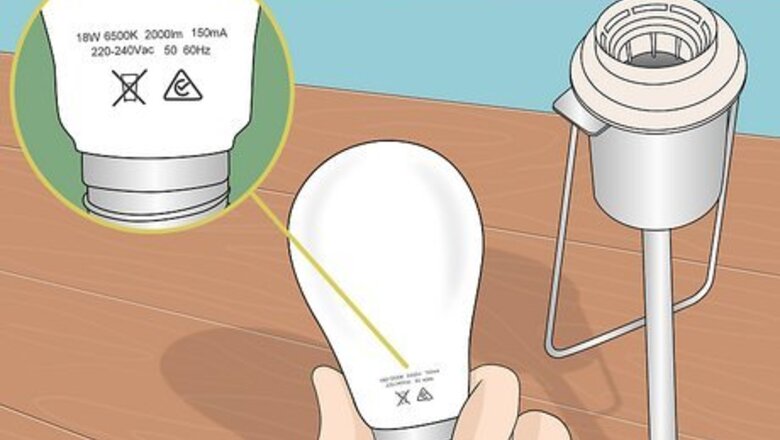
views
Determining Wattage, Voltage, and Base Size

Take the old bulb out of the fixture to find the type of base you need to buy. If you already have a bulb in the fixture, remove it to inspect the threading, size, and shape. You can use this as a reference or take it into the store with you when you go to buy your new bulb. Even if a bulb fits in the fixture, you still need to double-check the voltage and wattage for each bulb and fixture to make sure they line up. Don’t assume that just because a bulb fits that it’s safe to use.
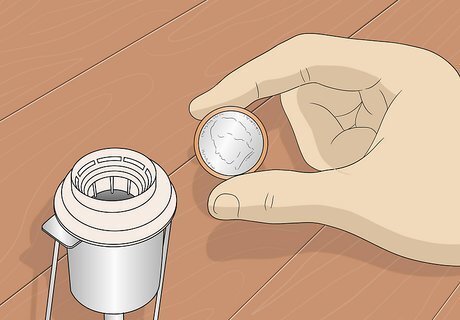
Measure or use a coin to assess the diameter of the fixture’s base if you don’t have a bulb. Since light fixtures typically come in three different sizes, you can use a coin to determine what type of bulb you need. Grab a quarter, dime, and a penny. Hold each coin over the opening for the bulb on a light fixture to determine the size of the bulb you need. You can always measure the opening if you prefer. Standard bulbs (also known as medium or Edison base bulbs) go into bases that resemble the size of a quarter. These are the most popular type of fixture base and they’re 26 mm in diameter. Intermediate bulbs are roughly the shape of a dime. These bases measure 17 mm in diameter. Candelabra bulbs have bases that are roughly the same size as Lincoln’s head on a penny. These small bases measure 12 mm in diameter. If your fixture looks like two pins slide into it, you have a bi-pin, twist-lock, or plug bulb. There are hundreds of these bulbs and you’ll need to read the instructions for the light fixture to figure out which bulb you need. For example, a G9.5 bi-pin can have a pin diameter of 3.1–3.25 millimetres (0.122–0.128 in), while a G12 bulb will have a diameter of 2.35 millimetres (0.093 in). Both bulbs will look nearly identical and they come in a variety of voltages, so you’ll have to read the instructions for the light fixture to ensure that you’re using the right bulb.
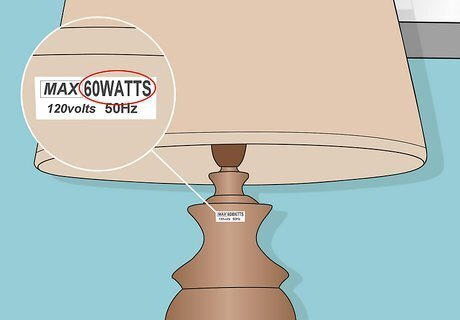
Find the fixture’s maximum wattage or use the old bulb’s wattage as a guide. Read the instruction manual for your fixture or look on the back of the fixture for a sticker listing the maximum wattage. If you had a bulb in the fixture that worked fine, you can assume the maximum wattage on the bulb is identical to the maximum wattage of the fixture. Never use a lightbulb with a wattage higher than the fixture’s max wattage. This will eventually destroy the fixture, but it can even cause a fire if you leave the light on for too long. This information is often printed on the inside of the base for the bulb on the fixture. You can absolutely use a bulb with a lower wattage than the fixture’s max wattage.

Check the voltage to see if it’s 12, 24, or 120 volts. Next to the maximum wattage information, look for a voltage. In the vast majority of cases, indoor lighting fixtures require 120-volt bulbs. Outdoor fixtures often require 12- or 24-volt bulbs, although smaller indoor lights may require these lower voltages as well. Purchase a bulb for your fixture that’s designed for the voltage of your fixture. You will destroy the bulb or the fixture if you use a bulb with the wrong voltage. In most cases, a bulb with an incorrect voltage won’t even turn on. If you got a new bulb and it won’t light up in your fixture, the voltage is probably incorrect.

Convert the wattage if you’re going from one type of light to another. Fixture wattages are typically based on incandescent light, which is mostly being phased out over time for energy reasons. If you are switching from one type of light to another, find the conversion by reading a light bulb’s packaging to make sure you aren’t exceeding the max wattage. This information is typically listed on the box of a bulb, but you may need to look the conversion up online if you can’t find it. For example, a 60-watt fixture requires an LED bulb that’s 8-12 watts, and if you’re going with a halogen bulb, it must be 43 watts. This is due to the fact that different types of bulbs produce different amounts of energy. This conversion measurement is often listed on a bulb’s box as the wattage “equivalent.” If you need a 60-watt incandescent bulb, you can use any light bulb that says “60-watt equivalent” on the box.
Selecting a Bulb Type

Opt for an LED bulb for a standard, energy-efficient option. LED bulbs are popular and easy to find. They also last longer than other types of bulb and a single lightbulb may work for 10-20 years. They come in a variety of colors and bulb shapes, which makes them a great option if you aren’t sure what type of light you prefer. Some people dislike LED bulbs because they tend to be a little brighter and sharper than the old incandescent bulbs people are used to. LED bulbs tend to be the most expensive but they last for so long that it’s often worth it in the long run. You find LED bulbs in almost every type of lighting fixture. They’re so efficient and popular that you can find them in almost every style.

Pick a CFL bulb if you want an efficient, whiter light. CFL is short for compact fluorescent. These bulbs use 20-40% less energy to produce the same light as incandescent bulbs. They are often color adjusted to produce light close to real sunlight. While they don’t last quite as long as LED bulbs, they’re still a relatively good option if you want a natural-looking light. CFLs generate a little more heat than LED bulbs which is why they’re generally not as popular. They tend to get very hot if you leave them on for a long time. Compact fluorescent light bulbs are commonly used in desk lamps, floor lamps, under-cabinet lamps, table lamps, linear strips, and sconces. CFLs have basically made fluorescent tube lighting entirely obsolete. If you really like the look of those old fluorescent tubes, get a CFL bulb. The feel of the light tends to be extremely similar.

Opt for halogen lights if you really dislike orange and yellow light. Halogen bulbs produce bright, vivid light. The main difference between halogen and other bulbs is that halogen light tends to feel blue. Halogen bulbs tend to burn out very quickly, but they’re a great choice if you really prefer sharper, bluer light. Halogen bulbs are popular options for track lighting, appliance lighting, and desk lamps. They aren’t usually great choices for overhead fixtures, though.

Avoid incandescent bulbs if you can since they don’t last as long. Incandescent lighting is what many people grew up with, but it’s wildly inefficient compared to the other options. It requires a lot of energy and it’s not great for the environment. On top of that, most countries have banned the manufacture of incandescent bulbs. It’s best to choose another option if you can. If you really love the look of incandescent lighting, look for a “warm” LED with roughly 800 lumens. The texture of the light should look nearly identical.

Get a 3-way bulb if you have a 3-way lamp that clicks. If you have a lamp with one of those switches that clicks as you turn it, you have a 3-way lamp. Purchase a 3-way bulb for your lamp. These lamps and bulbs have 3 different wattages and light outputs: low, medium, and high. When you turn the switch so that it clicks once, you’ll turn on the low-light setting. Turn it twice for the medium setting, and three times for the high setting. Many 3-way bulbs are incandescent, but there are 3-way LED and halogen bulbs as well. These bulbs are almost exclusively used in freestanding and table lamps. You won’t often find them on a wall fixture or ceiling light.

Read the label on a non-incandescent light bulb to see if it’s dimmable. Every incandescent light is dimmable, but only some LED, halogen, and CFL bulbs can be dimmed. On the bulbs that can be dimmed, it will say “dimmable” on the front of the packaging. Inspect the label carefully if you’re buying a non-incandescent bulb and you have a ceiling light or fixture with a dimmable switch. Dimmable light bulbs have adjustable voltages. When you turn a dimmer down, the voltage is throttled and less light is produced.
Picking the Brightness and Shape

Choose a bulb with more lumens for a brighter light. Lumens refers to the brightness of the light the bulb will put out (as opposed to wattage, which is the amount of energy). The higher the lumens, the brighter the light bulb will be. Read the package on the bulb to see how many lumens it produces. This is entirely a matter of personal preference, but you usually want more lumens for bright overhead lights and floor lamps, while desk lamps and track lighting usually require fewer lumens. The scale for lumens ranges roughly from 450-1600. A bulb with 800 lumens will produce an “average” amount of light. Again, how 800 lumens looks in your home depends on what you’re using the light for. A desk lamp producing 800 lumens will be really bright. An outdoor motion-sensor light will feel really dim at 800 lumens.

Pick a warmer color temperature for a yellowish light color. Most bulbs will advertise color temperature or light appearance on the package. This will give you a sense for the color and texture of the light. Although this may not be a serious consideration for you when choosing your bulbs, you might want to make sure you don’t accidentally purchase a bright white bulb when you intended to buy a warm yellow bulb. The softer the light is, the less harsh it will be when you look at it. Generally, softer lights are great for mood lighting and exposed bulbs. Harder lights are great for ceiling fans and lights that need to be bright. Harder lighting is often marketed as “bright” or “ultra-bright.” Warmer lights tend to have tints of yellow, orange, or red, while cooler lights tend to have a bluish tint. It’s entirely up to you which you prefer.

Buy an Energy Star Certified bulb if you can to save money over time. If you look on the packaging for the light bulb, it lists the estimated yearly energy cost and the lifespan of the bulb. If these numbers are lower than standard light bulbs and produce less heat, the bulb may have “Energy Star Certified” printed on the label. Buy these bulbs if you can—they’re much more efficient, cheaper to operate, and they’re good for the environment. Energy Star is the name of the certification program in the United States, but most countries have a version of this.
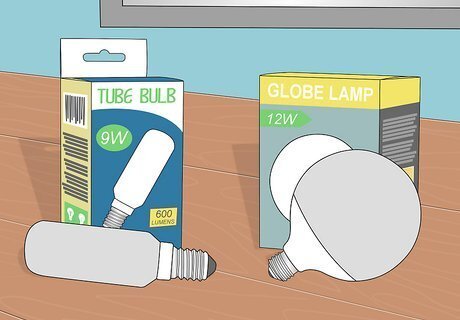
Choose a globe or tube bulb if you have a round or long fixture. Globe bulbs are perfectly round and emit an equal amount of light in every direction. These bulbs are great for round fixtures that are covered in glass since they will illuminate the entire cover in an even shade of light. There are also tube-style bulbs that are longer and designed for thinner, hanging lights and fixtures with vertical sconces. Tube-style bulbs come in a variety of sizes, so measure the length of a hanging fixture before purchasing a bulb to avoid getting a light that’s too short or long.

Get a recessed bulb for track lighting or directional lights. Unlike round bulbs, recessed bulbs have a flat surface that directs light downwards. If your light fixture is built into the wall or your want to focus the light in a direction, get recessed bulbs. These bulbs come in all types of lights and styles. If you put a regular bulb in a track or directional light, you’ll be wasting light on the sides of the bulb.

Opt for a candle bulb if you want fancy, decorative lights. Candle bulbs are a general term for the tube-shaped bulbs that often end in a point to resemble the flame from a candle. There isn’t much of a point to using them if you’re covering the bulb with a shade or cover, but they’re a cool option if the bulb is going to be exposed. This makes them a great choice for un-covered lamps, chandeliers, wall sconces, and modern lighting fixtures. These types of decorative lights come in a few different styles. There are pear-shaped, blunt-tip, and tapered candle bulbs for different fixtures and looks. These bulbs tend to look softer than their round counterparts, even when the wattage is identical.

Look for PAR bulbs if you’re setting up outdoor lighting. PAR stands for parabolic aluminized reflector. A PAR lamp can be incandescent, halogen, or LED. PAR lamps rely on an internal reflector and a prism in the lens for a controlled, focused light beam. These bulbs are extremely bright, so they’re great if you’re setting up a motion-sensor light. PAR bulbs are not a great option for indoor lighting. They’ll feel really overwhelming, even at a low wattage.



















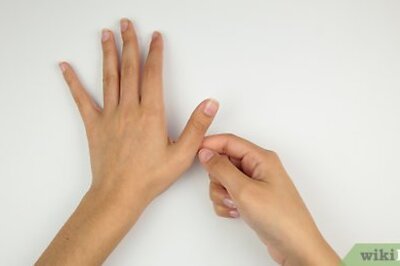
Comments
0 comment